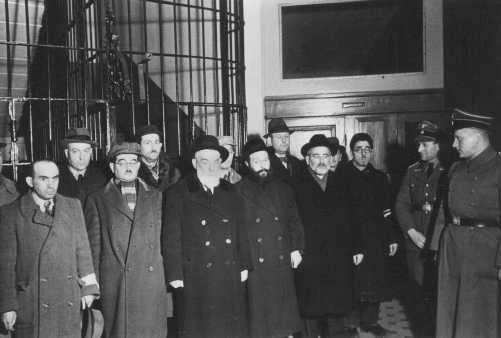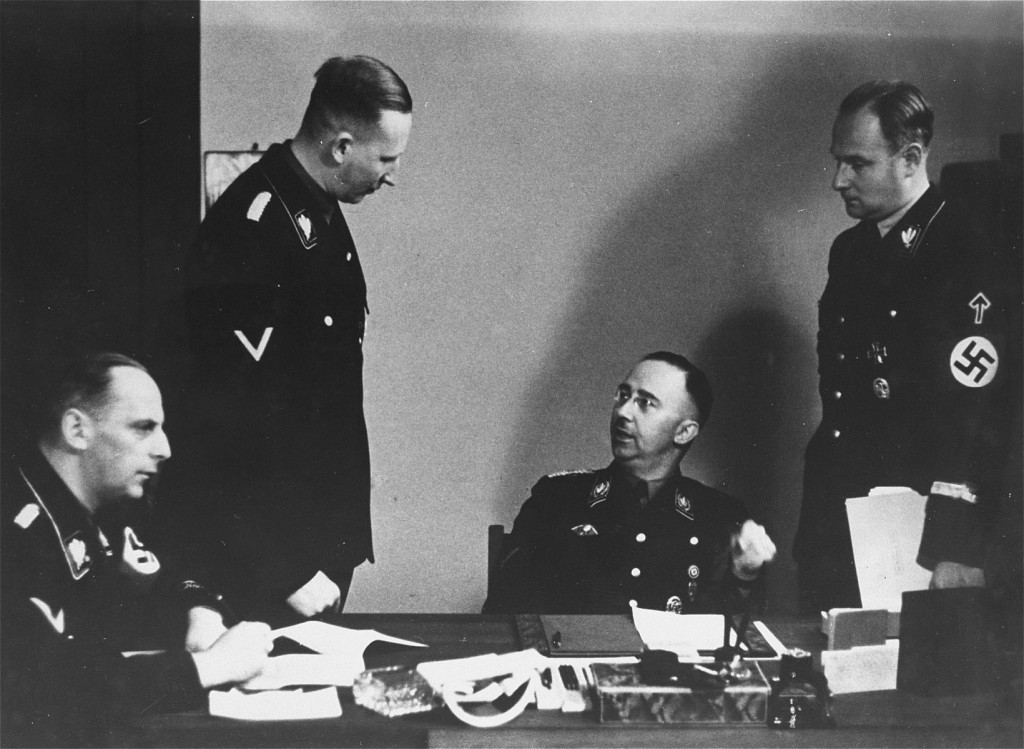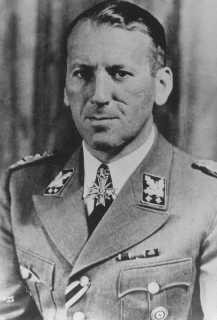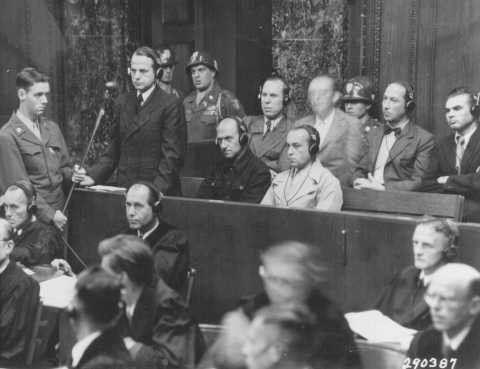
The Sicherheitsdienst (SD)
The SD (Sicherheitsdienst) was a Nazi Party intelligence service. It was part of the SS (Schutzstaffel, Protection Squadron), an elite Nazi Party paramilitary organization that was under Heinrich Himmler’s control. Over the course of the Nazi era, the SD took on an increasingly prominent role in Nazi anti-Jewish policies. Most infamously, the SD was a key component of the Einsatzgruppen.
Key Facts
-
1
For most of its existence, the SD was run by and closely associated with Reinhard Heydrich, an important Nazi figure in the history of the Holocaust.
-
2
In the 1930s, SS leader Heinrich Himmler and his deputy Reinhard Heydrich took steps to unite the SD with the Security Police (the Gestapo and the Kripo).
-
3
Units of Security Police and SD, including the notorious Einsatzgruppen, perpetrated many crimes of the Holocaust.
The Sicherheitsdienst (Security Service), usually called the SD, was a Nazi intelligence agency. The SD existed from 1931 to 1945. For most of this period, it was led by Reinhard Heydrich. The SD was an ideologically radical organization that became a key perpetrator of the Holocaust.
The SD was a subgroup of the SS (Schutzstaffel, Protection Squadron), the Nazi Party’s elite paramilitary led by Heinrich Himmler. As the intelligence service of the SS, the SD was responsible for gathering intelligence about the Nazi Party’s enemies, real and perceived. These supposed enemies included political opponents, Jews, and freemasons, among others. The SD became one of the Nazi regime’s key sources of information and knowledge about Jews. As such, the SD proposed and experimented with various methods for solving the “Jewish Question.”
The First Years of the SD, 1931–1933
SS chief Heinrich Himmler officially established the Sicherheitsdienst (SD) in the summer of 1931. He placed Reinhard Heydrich in charge of the new organization. Under Heydrich’s command, the SD grew from a small, underfunded organization into a key player in the Nazi regime.
Before the Nazis came to power in January 1933, Hedyrich’s SD was still quite small. In mid-1932, it had, at most, 33 full-time employees. In fact, it was initially only one of several Nazi intelligence organizations, which competed with each other for influence.
The early SD gathered intelligence on the Nazi Party’s political enemies. This meant that they spied on other political parties and government officials in Germany. But they also gathered intelligence on Hitler’s opponents within the Nazi movement and party. In particular, the early SD was concerned with collecting information on new members of the rapidly growing Nazi Party. The Nazis worried that the massive influx of supporters also included police spies and spies from other political movements.
The SD in the Early Years of the Nazi Regime, 1933–1936
Adolf Hitler was appointed chancellor of Germany in January 1933. At first, the SD did not have a clear role to play in the new Nazi regime. The organization remained small and underfunded. However, this began to change when on June 9, 1934, the SD was officially declared the only Nazi Party intelligence agency.
Later that month, Heydrich and other SD leaders played an important role in the Röhm Purge. This purge was a series of murders perpetrated between June 30 and July 2, 1934. It primarily targeted the SA (Sturmabteilung). The SA was another Nazi Party paramilitary that had been a loyal, radical, and violent force in the Nazi rise to power. But, by the summer of 1934 the culture and ideals of the SA no longer suited Hitler and the Nazi regime. Their violent impulsivity and demands for social revolution alarmed many Germans.
Himmler and Heydrich were both closely involved in encouraging, preparing, and perpetrating the purge. Prior to the purge, the SD had helped to compile lists of those to be murdered. Heydrich personally helped oversee events in Berlin, while other SD officers participated in the purge in Munich. The purge demonstrated the brutality of Heydrich and his SD officers and their loyalty to Hitler. Afterwards, the SD continued to grow in importance.
At the end of 1934, there were 850 full-time SD employees, almost twenty-six times more than when the organization first started. The men who joined the SD were typically young, in their twenties and thirties. They were also well-educated. Many had studied law. Most importantly, SD men were committed to Nazi ideals.

The Rise of Himmler, Heydrich, and the SD
The SD gained power in the mid- and late 1930s as its creator Heinrich Himmler rose to prominence in the Nazi hierarchy. As Himmler’s power increased, so did that of his deputy, SD leader Reinhard Heydrich.
The summer of 1936 was a key moment in Himmler’s rise. Himmler had been the leader of the SS, a Nazi Party position, since 1929. In June 1936, Hitler added to Himmler’s responsibilities by appointing him as Chief of the German Police. This was a government position that placed Himmler in charge of all German police forces. Thus, Himmler held two prominent positions at once, one in the Nazi Party structure and one in the government.
From his position as SS Leader and Chief of the German Police, Himmler began to elevate the SD to a more powerful position.
Combining the SD and the Security Police, 1936–1939
As SS Leader and Chief of the German Police, Himmler worked toward achieving his mission of combining the SS and German police. In this new SS and police system, he planned for the SD to work with Germany’s political and criminal police forces to target Germany’s enemies.
In the first half of 1936, however, the political and criminal police were still separate entities. So, to accomplish his goals, Himmler had to centralize and unite Germany’s political and criminal police forces. In June 1936, Himmler did so. He established the Main Office of the Security Police (Hauptamt Sicherheitspolizei, SiPo). The Security Police consisted of the Kripo (criminal police) and the Gestapo (political police).
At the same time that Himmler linked the Kripo and Gestapo to one another as the Security Police, he took steps towards combining them with the SD. Most importantly, Himmler appointed Heydrich as the head of the Security Police. This meant that Heydrich was now in charge of both the SD and the Security Police. His new title was Chief of the Security Police and SD. Like Himmler, Heydrich held two positions at once and served as the personal link between these two organizations.
Himmler and Heydrich hoped that the SD and the Security Police would work together. However, the structure of the Nazi Party and the Nazi regime made this somewhat difficult. This was a complicated new system that depended on the creation of dual positions that linked the Nazi Party to the German government.
How Did the SD and the Security Police Work in Nazi Germany?
In prewar Nazi Germany, the SD and the Security Police had different, but complementary roles. These roles were dictated by their different positions in the Nazi regime and by the structure of the German government.
The SD was a Nazi Party organization and subordinate to the SS. It was responsible for developing the theoretical aspects of intelligence and security. The SD was, at its core, a Nazi organization. SD officers viewed the world through the lens of Nazi ideology. And Nazi ideas shaped everything the SD did, including the structure of their intelligence system. The SD established separate intelligence departments to study Nazi Germany’s supposed domestic enemies. They created departments dedicated to Jews; left-wing marxist opponents; religious dissenters such as Jehovah’s Witnesses; right-wing nationalist opponents; and Freemasons. But because they were a Nazi Party organization, the SD did not have the authority to arrest potential enemies in Nazi Germany. This power rested with the German criminal justice system.
In contrast to the SD, the Security Police was a civil service organization within the German government. It was subordinate to the Chief of the German Police and the Ministry of the Interior. At its core, the Security Police was a policing organization. Security Policemen typically had police training, a knowledge of legal bureaucratic procedures, and investigative experience. Most importantly, the Security Police had police powers, namely the power to officially arrest people.
In theory, the division of labor meant that the SD would identify who or what constituted a threat, while the Security Police would carry out the actual arrests. In practice, however, there was significant overlap in the tasks of the Security Police and SD. As a result, they often competed with each other for influence. The function of the SD within the Nazi regime duplicated tasks that were typically for police, such as investigations and surveillance. By bringing the SD into the equation, Himmler and Heydrich eventually succeeded in radicalizing and Nazifying police practice.
The SD and the Security Police did not always work well together because of competition between them. In an attempt to remedy this problem, Heydrich created Inspectors of the Security Police and SD (Inspekteur der Sicherheitspolizei und des SD, IdS). Their job was to oversee all Security Police and SD units in a given region of Nazi Germany and to encourage cooperation.
In Germany proper, the SD and the Security Police always maintained their separate responsibilities and duties. However, these distinctions dissolved in German-occupied Europe. From the Nazi perspective, there were few legal limitations on what the SD and Security Police could and could not do in occupied territories. This was especially true in German-occupied eastern Europe.
The SD’s Wartime Intelligence Role

World War II began on September 1, 1939, with the German invasion of Poland. During the war, the SD and the Security Police had an important role to play in supposedly protecting Germany from its enemies. In recognition of their wartime importance, Himmler created the Reich Security Main Office (Reichssicherheitshauptamt, RSHA) on September 27, 1939. This office formally combined the Main Office of the Security Police with the SD. Heydrich led the RSHA until his death in June 1942. Eventually, another SS officer, Ernst Kaltenbrunner, took control of it.
The SD continued to grow during the war. By 1940, there were 4,300 full-time SD employees. In 1944 that number grew to 6,482.
As of 1941, there were two SD offices in the RSHA: Office III SD Domestic Intelligence (SD-Inland) and Office VI SD Foreign intelligence (SD-Ausland).
SD Domestic Intelligence during the War
In wartime Nazi Germany, the SD continued to gather intelligence on potential enemies. SD Domestic Intelligence (Office III of the RSHA) also compiled mood reports on the German population as a whole. In these reports, the SD would note things like how civilians reacted to wartime losses and what opinions they held of Hitler and other Nazi leaders.
SD Foreign Intelligence during the War
During the war, the SD Foreign Intelligence (Office VI of the RSHA) established intelligence networks abroad. They clandestinely operated on the territory of Germany's Axis partners. They occasionally conducted their own foreign policy in competition with the German Foreign Office. Another rival of the SD in the realm of foreign intelligence collection and analysis was the intelligence service of the German Armed Forces (Amt Auslands/Abwehr) under Admiral Wilhelm Canaris. In February 1944, this office was incorporated into the RSHA as Amt Mil.
The SD and the Holocaust
Security Police and SD units played an important role in the Holocaust. In many parts of German-occupied Europe, Security Police and SD leaders were responsible for coordinating and perpetrating horrific crimes. For instance, in the occupied Netherlands the Commander of the Security Police and SD (Befehlshaber der Sicherheitspolizei und des SD) was responsible for coordinating the deportation of Dutch Jews to their deaths.
The most notorious Security Police and SD units were the Einsatzgruppen (task forces or special action groups). Sometimes in English these are called mobile killing units. The Einsatzgruppen were units of the Security Police and SD created as early as 1938. Einsatzgruppen were assigned for duty in territories newly seized by the German armed forces. Their task was to carry out various security measures. Among these duties were identifying and neutralizing potential enemies of German rule, seizing important sites and preventing sabotage, and recruiting collaborators and establishing intelligence networks. The Einsatzgruppen were a consistently brutal perpetrator of Nazi occupation policies.
The Einsatzgruppen are best known for perpetrating massacres of Jews following the German attack on the Soviet Union in June 1941. Many SD men joined and led the Einsatzgruppen. Otto Ohlendorf, the head of the SD Domestic office in the RSHA, personally commanded Einsatzgruppe D. This unit deployed to southern Ukraine, Crimea, and the North Caucasus. On January 2, 1942, Ohlendorf reported that his unit had killed 17,645 Jews between November 16 and December 15, 1941, in western Crimea. According to this report, they had also shot 2,504 Krimchaks (a subgroup of Jews in Crimea), 824 Roma, and 212 Communists and partisans.
Ohlendorf’s report represents just one instance in which the SD perpetrated mass murder. All told, the SD was responsible for and involved in the murder of millions of people.
The SD on Trial at Nuremberg
At the end of World War II, it was clear to the Allied Powers that the SD was a major perpetrator of Nazi crimes. The International Military Tribunal at Nuremberg (IMT) found that the SD was a criminal organization.
The SD’s crimes were well-documented at the IMT and other postwar trials. Most notable was an affidavit from high-ranking SD officer Otto Ohlendorf. He admitted with shocking candor that under his leadership Einsatzgruppe D had killed 90,000 civilians, mostly Jews, in eastern Ukraine and the Crimea in 1941 and 1942. Ohlendorf was subsequently tried for crimes against humanity in what is often called the Einsatzgruppen Trial. He was found guilty and sentenced to death.


